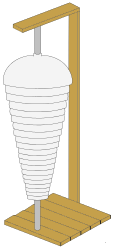Bell tree
 A simple bell tree, with holder | |
| Percussion instrument | |
|---|---|
| Classification | Idiophone |
| Hornbostel–Sachs classification | 111.242.221 (Sets of hanging bells without internal strikers) |
A bell tree (often confused with the mark tree) is a percussion instrument, consisting of vertically nested inverted metal bowls. The bowls, placed on a vertical rod, are arranged roughly in order of pitch. The number of bowls can vary between approximately 14 and 28. An effective glissando is produced by sliding a triangle beater, a glockenspiel mallet, or a xylophone mallet down the length of the tree. When a glissando is played, the inexactness of the order of the bowls' pitch is unnoticeable, merely creating a fuller sound.[1][2]
The bell tree is often used to accentuate the start or end of passages of music with a "bright", "shimmer" effect, adding complexity.[3]
Chick Corea and his group Return To Forever occasionally made use of the bell tree (i.e. album Hymn of the Seventh Galaxy), as has the group Santana. Isaac Howie has sometimes made use of the bell tree in his compositions.
References
- ^ "Bell Tree". Virginia Tech Multimedia Music Dictionary. 2012-10-17. Retrieved 2012-11-24.
- ^ Robert M. McCormick (1985-03-01). Percussion for Musicians: A Complete, Fundamental Literature and Technique ... Alfred Music Publishing. p. 41. ISBN 0769233651. Retrieved 2012-11-24.
- ^ Kalani (2008). All About Hand Percussion. Alfred Music Publishing. p. 21. ISBN 073904964X. Retrieved 2012-11-24.
